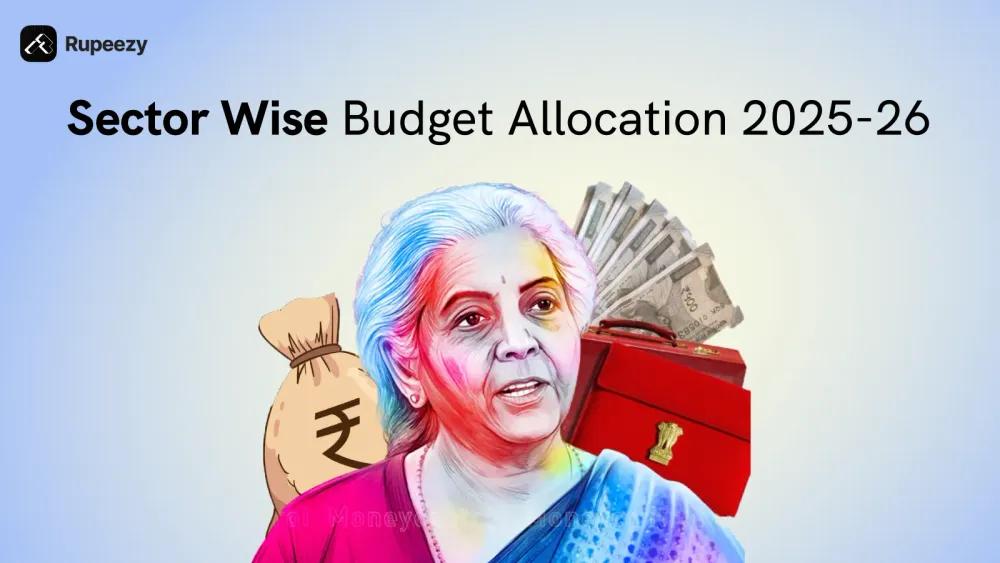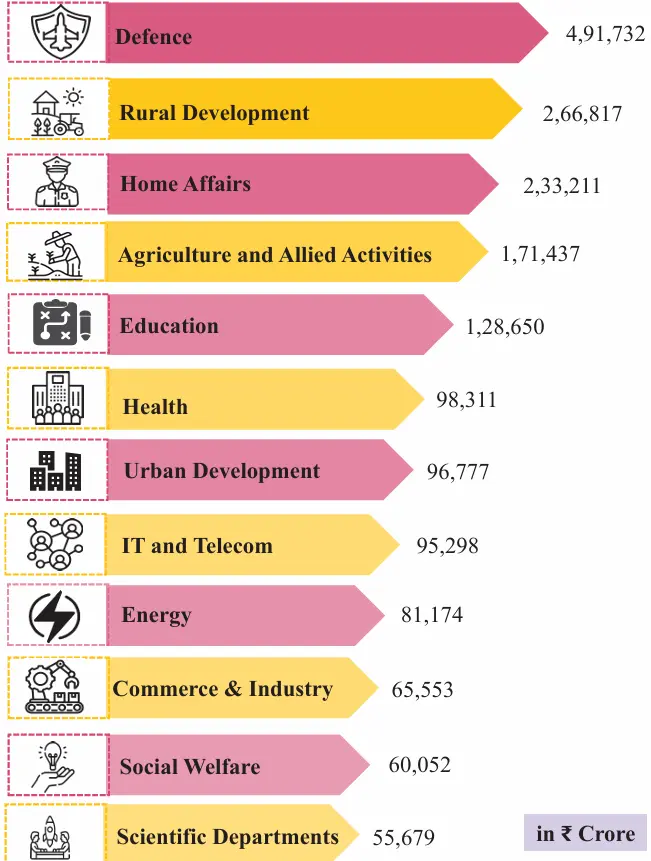Sector Wise Budget Allocation 2025: Defence, IT, Energy


00:00 / 00:00
Union Budget 2025 is finally announced on 1 February 2025 by Finance Minister Nirmala Sitharaman. This marks her record eighth consecutive budget presentation. This budget is particularly significant as it is the first full budget of Prime Minister Narendra Modi's third term.
The budget session started with President Droupadi Murmu addressing both Houses of Parliament. There are various anticipation linked to GDP growth, tax exemption, healthcare, and a new tax regime.
Varied measures are taken to give a boost to various sectors and industries. Here in this article, we highlight the key points linked to the sector wise budget allocations and announcements as per the Union Budget presented.
Sector Wise Budget Allocation Key Highlights
The Budget 2025 is aimed at promoting growth and inclusive development. The idea is to realize the true potential of ‘Sabka Vikas’ in the next five years. The sectors in the budget are selected based on the target which is ‘garib, youth, annadata and nari.’
Key highlights include agriculture, healthcare, education, power, and railway budget allocation. So, let us explore the budget allocation 2025 sector wise here.

Source: https://www.indiabudget.gov.in/doc/bh1.pdf
Defence Sector Allocations
Defence budget 2025 is focused on boosting the security of the country while ensuing the personnels are uplifted. It includes:
1. Increased Defence Budget
The Union Budget allocates more than Rs.6.8 lakh crore for the Defence sector in FY 2025-26, marking an increase of nearly 9% from the previous year's budget estimates.
2. Modernization of Military
Out of the total allocation, approximately Rs.1.8 lakh crore is designated for the modernization of military equipment, including new fighter jets, helicopters, warships, submarines, tanks, artillery guns, drones, and missiles.
3. Focus on Self-Reliance
A significant portion of the Defence budget is allocated for procuring weapons and systems from domestic suppliers to achieve self-reliance in Defence manufacturing.
4. Revenue Expenditure and Pensions
The allocation includes a revenue expenditure of Rs.3.11 lakh crore and a pension outlay of Rs.1.6 lakh crore, accounting for approximately 1.9% of India's projected GDP for 2024-25.
Agriculture Sector Allocations
Agriculture being the backbone of economy holds a prominent in this year’s budget with the primary reforms like below:
1. Prime Minister Dhan-Dhaanya Krishi Yojana
This initiative aims to develop 100 agricultural districts to enhance productivity and support 1.7 crore farmers. It focuses on improving production, processing, value addition, and marketing through organized Farmer Producer Organizations (FPOs).
2. National Mission on High Yielding Seeds
The mission focuses on developing high-yielding, pest-resistant, climate-resilient seeds to increase agricultural output and ensure food security.
3. Aatmanirbharta in Pulses
A six-year mission will be launched with a special focus on Tur, Urad, and Masoor. This initiative emphasizes developing climate-resilient seeds, enhancing protein content, increasing productivity, and improving post-harvest storage and management.
4. Enhanced Credit through Kisan Credit Card (KCC)
It facilitates short-term loans for 7.7 crore farmers, fishermen, and dairy farmers, with an enhanced loan limit of Rs.5 lakh to improve financial accessibility for rural communities.
5. Mission for Cotton Productivity
A five-year mission focused on improving productivity and sustainability in cotton farming, addressing challenges faced by cotton growers and enhancing their income potential.
6. Makhana Board in Bihar
It focuses on production, processing, value addition, and marketing of Makhana, supporting local farmers and the regional economy.
7. India Post as a Catalyst for the Rural Economy
It will offer services like institutional accounts, Direct Benefit Transfers, credit to micro-enterprises, and insurance, aiding rural economic development.
Power Sector Allocations
To fuel the economy speedily, power needs to be there and should offer consistent support. To ensure and build on this, here are the key sector wise budget allocations:
1. Power Sector Reforms
The government plans to incentivize electricity distribution reforms and expand intra-state transmission capacity. This will help improve the financial and operational health of electricity companies. States implementing these reforms can borrow an additional 0.5% of Gross State Domestic Product (GSDP).
2. Nuclear Energy Mission for Viksit Bharat
The initiative aims to develop 100 GW of nuclear energy by 2047 to support India's energy transition. Changes to the Atomic Energy Act and the Civil Liability for Nuclear Damage Act will encourage private sector partnerships. A Rs.20,000 crore fund will establish a Nuclear Energy Mission, focusing on developing Small Modular Reactors (SMRs) with a target to operationalize five by 2033.
Airway and Railway Sector Allocations
Improving the transport infrastructure is important. Focusing on the same here are the key points in airway and railway budget 2025:
1. Airways Sector Highlights
UDAN Scheme Expansion: Aims to enhance regional connectivity by adding 120 new destinations, facilitating travel for 4 crore passengers over the next decade, supporting helipads, and smaller airports in strategic locations.
Greenfield Airports in Bihar: Plans include developing greenfield airports and expanding Patna airport's capacity, along with establishing a brownfield airport at Bihta.
Domestic MROs for Aircraft: The export time limit for foreign-origin goods imported for repairs has been extended to one year, with a possible additional extension, promoting domestic Maintenance, Repair, and Overhaul (MRO) facilities.
2. Railways Sector Highlights
Capital Expenditure: The railway sector receives Rs.2.55 lakh crore, focusing on infrastructure, safety, and modernization.
Safety and Modernization Initiatives: Continued investments aim to improve safety and enhance passenger experience through modernization.
Domestic MROs for Railway Goods: The extension of the export time limit for imported railway goods supports domestic MRO development.
Finance Sector Allocations
To empower the people and offer them with more spending power, the sector wise budget allocation greatly focuses on finance. This includes:
1. Fiscal Management
The budget targets a fiscal deficit of 4.4% of GDP for 2025-26, emphasizing fiscal discipline while promoting economic growth.
2. Personal Income Tax Reforms
The budget introduces a revised structure for personal income tax, with the following tax slabs:
Up to Rs.4 lakh: Nil
Rs.4 lakh to Rs.8 lakh: 5%
Rs.8 lakh to Rs.12 lakh: 10%
Rs.12 lakh to Rs.16 lakh: 15%
Rs.16 lakh to Rs.20 lakh: 20%
Rs.20 lakh to Rs.24 lakh: 25%
Above Rs.24 lakh: 30%
3. Senior Citizen Tax Benefits
The tax deduction limit for senior citizens has been doubled from Rs.50,000 to Rs.1 lakh, providing additional relief to this demographic.
4. TDS on Rent Increase
The annual limit for Tax Deducted at Source (TDS) on rent has been increased from Rs.2.40 lakh to Rs.6 lakh, allowing more individuals to rent without incurring TDS.
5. Extension of Time Limits for Returns
The time limit for filing updated returns has been extended from two years to four years, easing compliance for taxpayers.
6. Support for MSMEs
Customized credit cards with a limit of Rs.5 lakh will be issued for micro-enterprises registered on the Udyam portal, facilitating easier access to finance.
Healthcare and Medicine Sector Allocations
Good health is key to success everywhere. Following this idea, here are some of the key allocations made in the budget for the healthcare and medicine sector:
1. Expansion of Medical Education
The budget proposes adding 10,000 medical college seats annually, aiming for a total increase of 75,000 seats over five years to meet the rising demand for healthcare professionals in India.
2. Day Care Cancer Centres
Plans include establishing Day Care Cancer Centres in all district hospitals to improve access to cancer treatment and provide timely care.
3. Improved Access to Lifesaving Medicines
The budget includes provisions for adding 36 lifesaving drugs to the exempted list and six medicines to the 5% duty list. Additionally, it introduces 37 new medicines with 13 patient assistance programs for rare diseases and chronic conditions.
4. Healthcare Coverage for Online Platform Workers
It will extend PM Jan Arogya Yojana coverage to online platform workers, ensuring access to health services.
5. Investment in Health Infrastructure
There is a continued emphasis on enhancing health infrastructure, particularly in rural and underserved areas, to ensure equitable access to quality healthcare services.
Education Sector Allocations
Education is key to upkskilling people and innovation. The key sector wise budget allocation for education include:
1. Atal Tinkering Labs
The government plans to set up 50,000 Atal Tinkering Labs in government schools over the next five years to foster creativity and innovation among students.
2. Broadband Connectivity
There will be efforts to provide broadband connectivity to all government secondary schools and primary health centers in rural areas, ensuring better access to digital resources.
3. Bharatiya Bhasha Pustak Scheme
This scheme will provide digital Indian language books for school and higher education, promoting linguistic diversity and accessibility in education.
4. National Centres of Excellence for Skilling
The establishment of National Centres of Excellence for skilling will be prioritized, focusing on global expertise and partnerships to enhance vocational training.
5. Centre of Excellence in Artificial Intelligence
A total outlay of Rs.500 crore is allocated for a Centre of Excellence in Artificial Intelligence dedicated to advancing educational technologies.
Tourism Sector Allocations
India is a country of culture and nature which welcomes hundreds of people every year. But its needs a boost and considering the same, here are the steps taken in the budget 2025:
1. Development of Top Tourist Destinations
The government, in partnership with state governments, plans to develop 50 top tourist destinations, enhancing infrastructure and leveraging India's rich heritage to boost economic growth.
2. MUDRA Loans for Homestays
The budget extends MUDRA loans to homestays, promoting rural and small-scale tourism enterprises by facilitating access to credit, boosting local economies, and creating employment in tourism and hospitality.
3. Promotion of Medical Tourism
The government aims to enhance India's role as a hub for affordable, high-quality healthcare by promoting medical tourism in collaboration with the private sector.
4. Focus on Spiritual Tourism
The budget supports the development of destinations linked to Lord Buddha, strengthening India’s position as a center for spiritual tourism.
Infrastructure Sector Allocations
For any business or reform to flourish, it is important to have a good infrastructure. Based on this, here are the reforms defined in the Union Budget 2025 for the infrastructure sector:
1. Support to States for Infrastructure
The budget provides Rs.1.5 lakh crore in 50-year interest-free loans to states for capital expenditure to boost infrastructure in transportation, urban development, and rural connectivity.
2. Urban Challenge Fund
Rs.1 lakh crore is allocated to transform cities into growth hubs under the Urban Challenge Fund, enhancing creative redevelopment and water and sanitation facilities.
3. Asset Monetization Plan
A plan to generate Rs.10 lakh crore by monetizing existing assets from 2025 to 2030, reinvesting the proceeds into new infrastructure projects.
4. Jal Jeevan Mission
Extended until 2028, this mission aims for 100% coverage of rural water supply, ensuring every household has access to clean drinking water.
5. Maritime Development Fund
A new fund with a corpus of Rs.25,000 crore will support long-term financing for maritime infrastructure projects, boosting the maritime sector.
6. Infrastructure Support for Rural Areas
Financial backing is provided for improving rural infrastructure, notably through the Western Kosi Canal project in Bihar’s Mithilanchal region, which aims to enhance irrigation and support local agriculture.
Footwear and Leather Sector Allocations
The government has introduced a Focus Product Scheme for the footwear and leather sectors, aimed at boosting employment and industry growth. This initiative is set to support about 22 lakh individuals, aiming for a turnover of Rs.4 lakh crore and exports over Rs.1.1 lakh crore. It also provides assistance to MSMEs, enhancing their capacity to produce quality products for global markets. Additionally, there is a strong emphasis on skill development to equip the workforce with industry-specific skills.
Toy Sector Allocations
Building on the National Action Plan for Toys, the 2025 budget introduces a scheme to position India as a global toy hub. It emphasizes developing manufacturing clusters, skill enhancement, and establishing a strong manufacturing ecosystem to produce unique, high-quality, and sustainable toys under the 'Made in India' brand. This strategy aims to increase domestic production, boost exports, and create job opportunities, while promoting local craftsmanship and competing globally through innovation and quality in toy manufacturing.
Conclusion
With this, you now have an overview of the sector wise budget allocation for Union Budget 2025. Keep this in mind while you plan your investments and finances. Focus on every minute detail to ensure that you gain the best.
Check Out These Related Articles |
The content on this blog is for educational purposes only and should not be considered investment advice. While we strive for accuracy, some information may contain errors or delays in updates.
Mentions of stocks or investment products are solely for informational purposes and do not constitute recommendations. Investors should conduct their own research before making any decisions.
Investing in financial markets are subject to market risks, and past performance does not guarantee future results. It is advisable to consult a qualified financial professional, review official documents, and verify information independently before making investment decisions.

All Category










